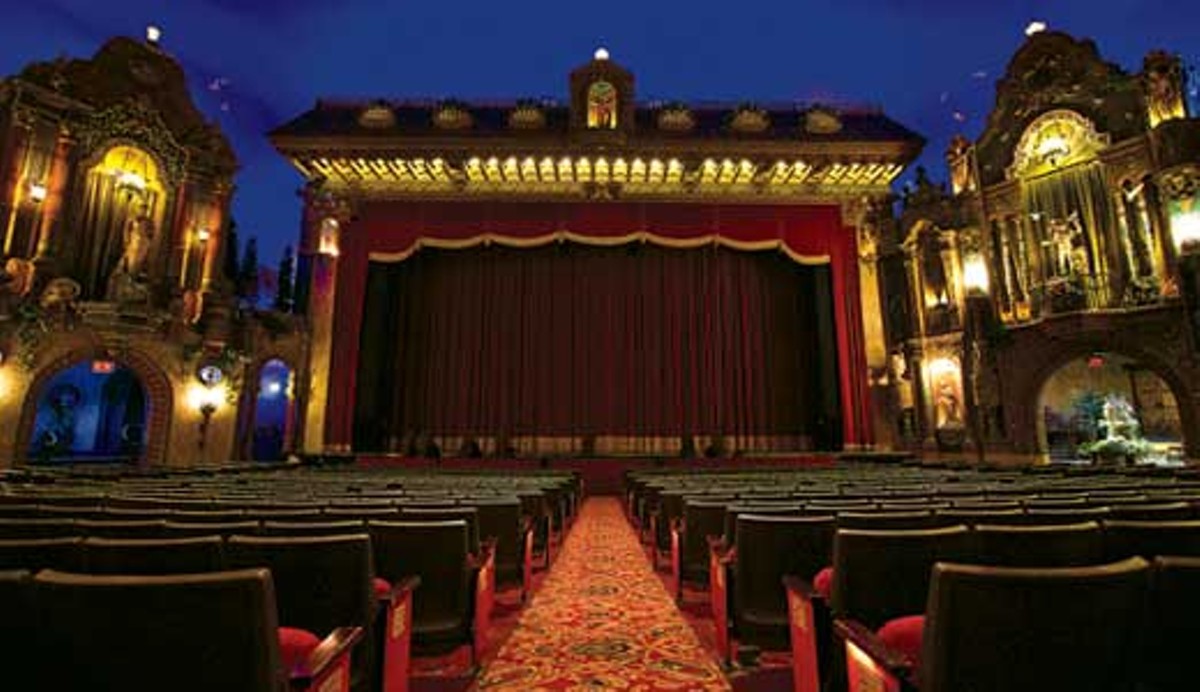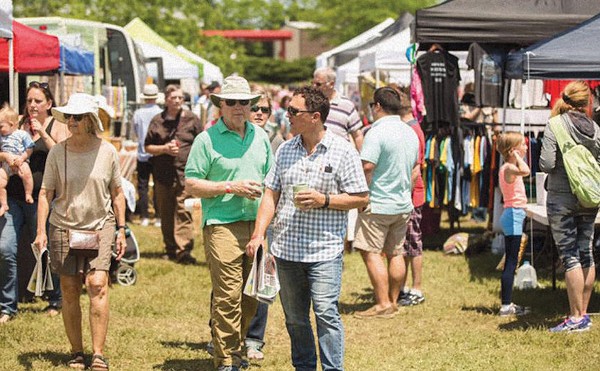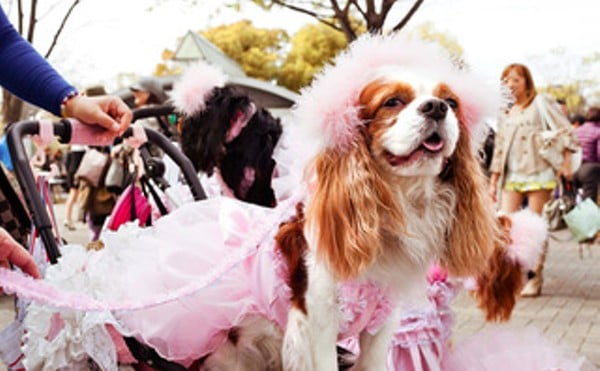The Louisville Palace is so over-the-top opulent, you might call it “Hollywood Gaudy Baroque.”
And that’s a compliment.
The historic theater has been an epicenter of entertainment in Louisville for the better part of eight decades. After falling into disrepair and sitting dormant for a portion of the late 20th century, the theater was restored and reborn, and the extravagant venue has since regained its status as a one-of-a-kind hub for music, theater and film. With its seashell-shaped auditorium lights, busts of famous people, from Shakespeare to Mozart, and replicas of Michelangelo’s and Donatello’s “David” statues, there’s much to marvel at upon walking through the doors at 625 S. Fourth St.
But the unique aesthetics of the Palace make up just part of its rich history, which includes frequent visits from famous Chicago gangster Al Capone. Oh, and it just might be haunted.
LEO recently spent some time with the keepers of the Palace on a quest to unlock its secrets.
At the beginning of the 20th century, going to the movies entailed more than merely seeing a film — it was an experience. Escapism was the goal, so theaters drew people in with architecture that would transport them to another locale. The make-believe world of cinema started long before the credits hit the screen.
“In our big modern movie palaces, there are collected the most gorgeous rugs, furniture and fixtures that money can produce,” decorator Harold Rambusch said in 1930. “No kings or emperors have wandered through more luxurious surroundings. In a sense, these theaters are social safety valves in that the public can partake of the same luxuries as the rich and use them to the same full extent.”
At the time, Fourth Street was an entertainment mecca in River City. Movie palaces like the Mary Anderson and Rialto lined the street. The only remaining cinema from those heady days of yesteryear is the Louisville Palace, designed by Austrian-American architect John Eberson (1875-1954).
A leading architect of movie houses in the early 20th century, Eberson worked as an electrical engineer (his specialization at the University of Vienna) in St. Louis after moving to the United States in 1901. By 1908, he had opened an architectural firm in the Cincinnati suburb of Hamilton, Ohio, the site of his first traditional theater. The firm eventually relocated to Chicago and then New York City.
In the 1920s, two types of theaters existed: the standard or traditional and Eberson’s “atmospheric” theater. The standard theater used classical motifs such as columns, crystal chandeliers and domes. Atmospheric theaters took those traditional elements and cranked them up with color and kitsch, adding trademark deep blue ceilings with projected clouds and low-wattage stars, all for a cost less than that of the standard.
It was his invention of the “atmospheric” style of movie palace that made Eberson famous. His first atmospheric theater was the 1923 Majestic in Houston. (Texas has the honor of having the last atmospheric theater built by Eberson, also called the Majestic, in San Antonio in 1929.) Dubbed “Opera House John,” he designed nearly 100 atmospheric theaters during those years.
Eberson once said his atmospheric style was inspired by “visions of Italian gardens, Spanish patios, Persian shrines and French formal gardens …” He achieved his goal of a “magnificent amphitheater under a glorious moonlit sky … where friendly stars twinkled and wisps of clouds drifted.” The more exotic, the better.
In Louisville, Loew’s Theaters and United Artists’ Theater Circuit commissioned Eberson to design a new movie house on the site where the St. Joseph’s Infirmary once stood. Upon opening on Sept. 1, 1928, the new Loew’s Theater on Fourth Street became the largest movie house in Kentucky and one of the largest in the South, with seating for 3,273 people.
Although originally designed as a silent film theater, “talkies” were becoming increasingly popular, meaning Eberson had to alter his plans to accommodate the sound equipment.
When it was finished, at a cost of more than $2 million, there were artisan-made plaster moldings, elaborate upholstery and exotic tiles, resulting in a Spanish Baroque fantasyland. Art was everywhere. Ornate banners and gilded mirrors covered the rustic, textured plaster walls. Carved heavy wood furniture was placed throughout the building. Stuffed birds were perched on plants and trees, with some strung from wires as if in flight.
The venue was popular with local patrons and out-of-town guests alike. When gangster Al Capone was in Louisville during Prohibition, he is said to have frequented Loew’s. While staying at the Seelbach Hotel, legend has it he would travel to the theater via underground tunnels once used for steam heat and deliveries.
After being dark for a portion of the ’70s, the building reopened in 1981 to much fanfare as a live performance venue. One of the new owners, local businessman John Siegel, appreciated its rich history and decided to restore it. The Louisville Palace was reborn and was added to the National Register of Historical Places in 1982.
But bygone opulence is expensive to bring back to life. The Louisville Palace again shut its doors in 1985, with Siegel filing for bankruptcy in 1991. Sunshine Theatre Inc., with Siegel involved as a minority partner, bought it later that year, and it reopened in 1994.
In 1996, the theater changed hands again, as it has several times since, with owners including Theatre Management Group, Clear Channel Entertainment and, as of 2005, the entertainment giant Live Nation.
With some major restorations, old is new again, and the Louisville Palace has fused nicely with 21st-century entertainment tastes.
The textured metal façade and original ticket booth remain intact. The tall blade boasts “Palace,” covering up the old “United Artists” sign underneath.
There are thousands of lights, both inside and out, a sparkling spectacle that requires much work to maintain. “We spend a lot of time changing light bulbs,” says production manager and technical director Casey Clark, who has been with the Palace since 2000.
The Palace is a building that plaster built, resulting in intricately crafted details, which are in full force in the grand outer lobby.
Restoration plasterers/painters Mary Zoeller and Alice Baldwin worked for several years on the building in the mid-2000s, giving them an up-close view of the intricate details. “Every time we went in,” Zoeller says, “we saw something new.”
They had their work cut out for them. “We were working by the seat of our pants,” Baldwin says. “We’d say, ‘What are we going to fix today?’ Every time a show goes in there, it’s like a party in a wedding cake. Things get broken.”
Zoeller agrees. “People treat it like their houses; they lean against the walls, they put their feet up against it, hit it with their bags. Plaster is real sensitive to any kind of moisture and vibrations, so stuff was just falling apart.”
A plaster replica of Donatello’s “David,” located over the doors leading into the outer lobby, was in place at the opening 82 years ago. The two fish fountains in the lobby also are original. “In 1928, the fountains were working,” Clark says. “The fish spit the water into the basin, and the water splashed a little. Around 2002, we got the fountains working again, but the water bill was too high.”
There are sculptures of faces and strange creatures everywhere, especially in the outer lobby. “It’s very European to do faces,” Baldwin explains. “It’s more interesting and atmospheric.” She calls the Palace’s style “Spanish Baroque on acid.” “Eberson’s not subtle,” she says. “If he was interested in it, he included it.”
The lobby flooring is the original terrazzo (marble chips mixed with concrete). Terrazzo accents are also on the grand staircase leading up to the second-floor mezzanine.
Deep reds and cobalt blue are used throughout, the latter of which was especially popular in Jazz Age decor. Since the lights originally were low to help set the mood, the colors are bright.
Many of the theater’s original banners, furniture and suits of armor disappeared over the years, possibly during the major restoration overseen by Siegel, according to Clark. That said, she credits Siegel with saving the Palace. “Renovation is an ongoing process,” Clark says. “We never stop working on it. And from a maintenance point of view, you can’t.”
In 1995, Louisville’s Preservation Alliance gave its Preservation Award to Siegel and Sunshine Promotions “for the superb restoration of an important community landmark.”
Stroll through the Palace and you’ll be greeted by dozens of faces from the past. In what’s come to be known as “the ceiling of celebrities,” a barrel vault ceiling in one of the smaller lobbies contains 139 sculpted busts of historical figures. The 12 men depicted are Apollo, Bach, Beethoven, Dante, Handel, Listz, Moliere, Mozart, Schubert, Shakespeare, Socrates and Wagner. Each bust repeats up to 13 times.
The ceiling also contains a single face of Eberson, a surprise gesture from his plasterers (across the lobby from the Aisle 3 sign, third row up). One of the Shakespeare busts was removed so that Siegel could be up there as well (to see it, stand near the base of the stairway).
Stairs from the faces lobby and the outer lobby reach up to the mezzanine. Some of the statues are 1928 originals, such as the “Faun” at the top of the outer lobby stairs. The companion sculpture “Flora” was thought to have disappeared (only to resurface in the auditorium), and should be where the bad copy of Michelangelo’s “David” is located. The magnificent winged “Michael,” added to the theater during the mid-2000s, is farther down the mezzanine.
It’s in the auditorium, which seats 2,711 today, where Eberson’s genius really shines. A Spanish courtyard garden, complete with alcoves, fountains and statuary, surrounds the seats. Patrons at the 1928 opening could look up at the dark blue “sky” to see twinkling stars and clouds as if under a nighttime sky.
The ceiling motif was inspired by a photograph of stars in an issue of National Geographic, which Eberson studied to determine exactly how to space the bulbs. An original sign in the building stated: “Please do not turn on the clouds until the show starts and be sure that the stars are turned off when leaving.”
Two-story architectural facades run along the auditorium walls, encasing the seating area. “Balconies off houses, windows into houses, a landing on the staircase … the architect was interested in building facades and architectural edifices, so it’s like walking around in a city,” Clark says.
In the auditorium, less is definitely not more: large sconces shaped as shells line the balcony, horse head sculptures are tucked in nooks, cherubs and sea horses adorn tall columns. A niche houses a working fountain that’s now covered with fake plants. “The fountain was once on,” says Clark, “but people complained it was too loud.”
Then there are the stuffed birds — pheasants, peacocks, doves. “(Eberson) had a parrot and was big bird guy,” Baldwin says.
Back in its old cinema days, the theater housed a 1,000-pipe Wurlitzer organ. It was sold in 1978.
During the Palace’s summer movie series, the theater lives again as a cinema, albeit temporarily. This year’s showing of Hitchcock’s “Rear Window” had the highest attendance for a single movie during the summer series with 1,544 viewers.
The Palace’s storied past also includes legends of a more supernatural nature — the place is supposedly home to several ghosts. Reported sightings include a laughing child in the women’s restroom and the “gray lady,” called so because she is always seen in a gray period dress with a program in hand. One spirit, seen in various locations in the building, is reported to be Ferdinand Frisch, an employee who died in the theater in 1965.
Both Zoeller and Baldwin claim to have had encounters with spirits, but as Zoeller says, “They liked the renovations, so they weren’t mean to us. I don’t think there are any mean ghosts there.”
Zoeller saw a man in a tuxedo at a time of day when no one was supposed to be in the building except the workers. To be more precise, she saw a nicely dressed arm on the railing of the stairs. By the time she looked again, the apparition was gone.
Baldwin came in one day to find a pile of cigar ashes on the stairs in the lobby of famous faces. In the days before the building became a non-smoking facility, there was a frequent visitor in a bowler hat who used to smoke his cigar by the post at the base of those stairs. A staff member believes the ashes were there because she had left her work cart out, right where the ghost used to stand. He must not have been pleased.
General Manager David Bartlett’s dog Max may have had a run-in with the “cigar ghost” as well. He often accompanies the staff as they move around the building. One day, he was fixated and barking at that post; while no human saw anything, it seems Max did.
There also are reports of an antique bench that mysteriously moves back and forth from the men’s and women’s restrooms, apparently not at the hands of any employee.
Given the theater’s rich history, a few ghost stories are to be expected.







